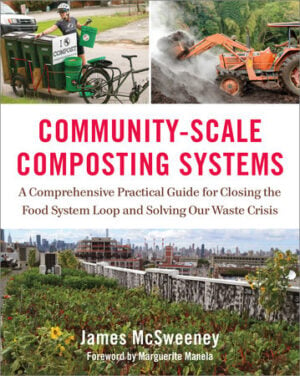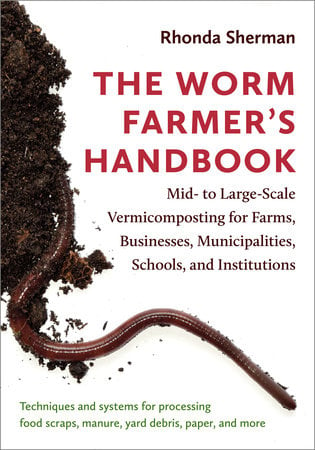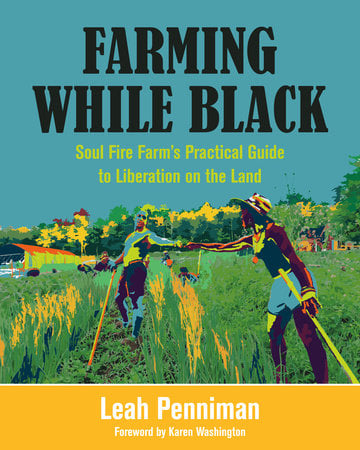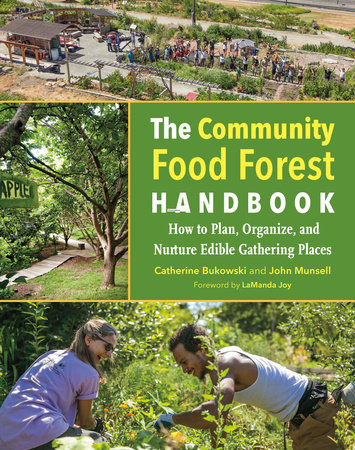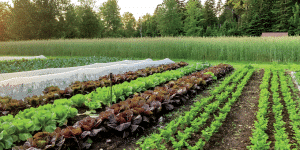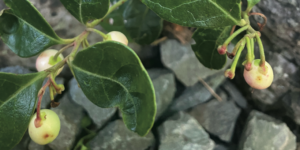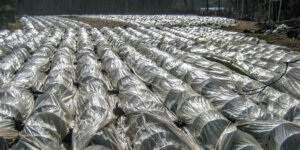Composting: Breaking Down the Core Principles
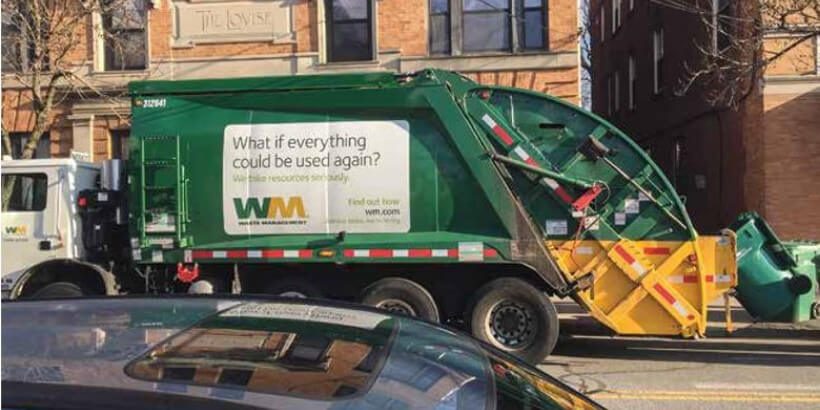
Composting is about more than just flinging your food scraps into a heap in your backyard. It’s about figuring out a way to give your unwanted food a new purpose while also helping the environment. And the best part is, the fundamental building blocks of composting systems are the same regardless of scale.
The following is an excerpt from Community-Scale Composting Systems by James McSweeney. It has been adapted for the web.
In every system organic refuse is generated, collected, and then composted. These three basic components are necessary whether the source comprises a single residence composting food scraps in the backyard or all of the organics generated by a city. Everyone on the planet generates organic “wastes,” just as we all eat and breathe. A 2014 estimate by the US Environmental Protection Agency reports that 38.4 million tons of food scraps are generated in the United States each year, with only 5.1 percent recovered and recycled. In that wasted material is embodied tremendous resource potential. Naturally, an enormous diversity of systems to capture, transport, and recycle organics has developed from this resource niche. But composting wouldn’t exist without the fourth fundamental component of these systems, the end uses. These include a wide range of compost applications and markets, as well as other forms of soil fertility, animal feed, and energy.
The subject of this book is organics recycling systems composed of these four basic components, handling organics at volumes above the scale of a single home and below the scale of a whole large city—in other words, community-scale. When planned appropriately, community-scale composting systems can handle the organics generated by a specific population, neighborhood, or region. Across the United States composters operating at this scale are emerging at a growing pace, as is an awareness of the benefits and services provided by composting. In my experience this sector of composters is typically focused on producing a very high-grade end product. Small-batch, horticultural, boutique, organic, bicycle-powered, artisan, community-based: There is no end to the ways in which these producers can be classified. What is increasingly apparent from this boom is that (1) there remains an abundance of waste; (2) awareness of the problem is growing; and (3) people are actively intervening to build the systems to collect, recycle, and reuse available organic resources in their communities.
The rapid growth and maturation of composting has led to a healthy discussion about what a functional and efficient organics recycling infrastructure can and should look like. One result of this discussion has been the solidification of a self-identifying segment of composters referring to themselves as “community composters.” Appropriately, the concept of community composting seems to have developed organically and with no single particular origin. Rather, organizations, projects, and even news articles appear to have taken on the term for its succinctness, though with their own slightly varying definitions. I first started using the term to describe the services we provided while working at the Highfields Center for Composting. At first I found it hard to define exactly what we were doing, but clearly it involved composting, community, education, and infrastructure. Over time I learned to describe what we did as “supporting the development of community composting programs,” and eventually our motto became “your partner in community composting.” It wasn’t until the 2012 US Composting Council Conference in Orlando, Florida, that the presence of a plethora of similarly minded practitioners around the United States helped the concept truly come into focus.
I wasn’t the only one whose eyes were opened at that conference. Within the year conference calls and planning for the first national convergence of community composters were ongoing. In the fall of 2013, the composting industry’s leading publication, BioCycle, and the Institute for Local Self Reliance (ILSR) hosted the first Cultivating Community Composting Forum in Columbus, Ohio, convergence that has continued annually.
In 2014 Highfields Center for Composting (HCC) and ILSR wrote the first comprehensive guide on the subject, Growing Local Fertility: A Guide to Community Composting (which Brenda Platt of ILSR, Jenn Davis, and I co-authored, and from which portions of this book are adapted). We faced the question of defining community composting for both ourselves and our audience, which took a great deal of time and thought. We decided that it was critical to involve other community composting practitioners and advocates in the process and reached out to several of the players that were involved in the development of the national community composting forum for their input. The team also agreed that the development of defining principles, rather than a set of exclusive criteria, would have the greatest long-term impact on the culture of composting as a whole. We wanted the vision for community composting to feel inclusive to the wide array of practitioners who identify with the term, and ideally to act as a standard of social and environmental ethics toward which anyone in the organics recycling sector could strive.
The team arrived at the following set of Core Community Composting Principles:
1. Resources recovered. Waste is reduced; food scraps and other organic materials are diverted from disposal and composted.
2. Locally based and closed loop. Organic materials are a community asset and are generated and recycled into compost within the same neighborhood or community.
3. Organic materials returned to soils. Compost is used to enhance local soils, support local food production, and conserve natural ecology by improving soil structure and maintaining nutrients, carbon, and soil microorganisms.
4. Community-scaled and diverse. Composting infrastructure is diverse, distributed, and sustainable; systems are scaled to meet the needs of a self-defined community.
5. Community-engaged, -empowered, and -educated. Compost programming engages and educates the community in food systems thinking, resource stewardship, or community sustainability while providing solutions that empower individuals, businesses, and institutions to capture organic waste and retain it as a community resource.
6. Community-supported. Programming aligns with community goals (such as healthy soils and healthy people) and is supported by the community it serves. The reverse is true, too. A community composting program supports community social, economic, and environmental well-being.
What Is Compost?
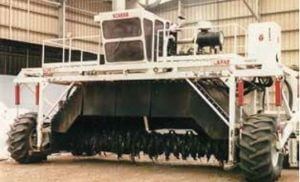
A compost windrow turner at the Albuquerque Soil Amendments Facility, 2003.
No book on the subject of composting can escape this inevitable question. The definition of composting that I have been using for a number of years, which is a combination of several definitions I’ve come across, is:
The return of organic materials to a rich, stable, humus-like material through a managed oxidative decomposition process that is mediated by microbe metabolism.
But compost is much trickier to define. If you’ve ever purchased compost, you may have ended up with any number of things: rotted manure rife with weed seed; mulch that someone tried to pass off as compost; leaf mold; dehydrated digestate solids; or beautiful, mature, organic-matter-rich, earthy, crumbly, black, life-giving . . . well, what else? . . . compost.
It’s hard to say with any authority what is or isn’t compost, because compost has both a history and a future of transformation. It was once something entirely different; now it’s compost; and soon it will yet again be something else. The challenge with defining compost perhaps stems from the definition of composting. The criteria for each of composting’s defining traits—organic waste, stability, managed, oxidative—can be met in any number of ways, which are often not the least bit equivalent. Metabolized by microbes might actually be the most straightforward characteristic of compost, and that’s saying something.
I believe in an inclusive definition, though looking at the end product of the composting process, I view some composts as being more compost than others. At the “very compost” end of the spectrum, the material is mature and stable, meaning there is little food energy (carbon) available to microbes from the original parent material. Virtually all of that potential energy has been consumed, and what remains is an enormous population of living, breathing organisms, the most complex forms of carbon—well on their way to becoming those mysterious “humic substances”—and the non-organic minerals endogenous to the original raw materials. The organisms and stable organic matter in compost contain the building blocks of healthy soil. Embodied within are energy, nutrients, and a structure that mimics a fully developed soil ecosystem capable of sustaining plant life. Compost is both the hardware and the operating system needed for creating healthy soil, ready to support the life of the land.
At the “sort-of compost” end of the spectrum are products created in a hurry, or with a high percentage of materials that are non-compostable, or based on misinformation about the composting process. Often one or two minor management adaptations can make a huge difference in quality. There may be high levels of non-organic matter, including minerals or plastics, or of the original raw non-decomposed organic matter. Many scenarios can lead to composts on the low-quality end of the spectrum; once you know what you’re looking for, you’ll see examples everywhere you look. While these compost-like materials may offer some value depending on the circumstances, it’s important to understand the benefits or drawbacks to using the specific product in a gardening or farming application. Don’t waste your time (or someone else’s) utilizing or creating a product that will not produce the desired effects. With some basic knowledge, anybody can reliably produce great material. Throughout this book, I’ll cover some of the desirable and undesirable qualities of different composts and the scenarios that lead to these qualities.
The Cult of Compost
For many people the need to compost, once awakened, is insatiable. Composting calls, it speaks from the beyond, drawing in believers. Seriously, farmers and others who make compost often describe the positive effects composting has on their minds and spirits almost like a meditation or yoga practice. A large number maintain a deep belief in composting as part of a holistic way of life.
I share this for a few reasons. First, if you are an inadvertent member of the Cult of Compost, know you are not alone. We are legions strong and spreading from root to sky. Second, you should know that a species of soil bacterium (Mycobacterium vaccae) releases serotonin. Chris Lowry, a neuroscientist studying the role of bacteria like M. vaccae in serotonin release, describes the effects of the bacteria as “basically no different from all the SSRIs” (such as Prozac). There are no studies to date about dependency concerns with Mycobacterium. And there are no doubt other microbes with similar effects. Third, to define compost strictly as a substance that has undergone biologically mediated oxidation misses the fact that there is a huge social aspect to composting. Similar intersections between technology, social order, and microbial communities have a long and beautiful history (I’m thinking of the fermentation traditions of the Tarahumara and Lacondon peoples of Mexico). Those traditions are also a path to both community and the divine.
This is all to say, composting may play a more important role than we recognize in creating greater wellness in our communities. Have no fear in taking on a holistic view (but try to leave the dogma out).
Recommended Reads
Recent Articles
No heated greenhouse? No problem! Discover the secrets to thriving winter gardening without breaking the bank.
Read MoreWintergreen is the stunning evergreen groundcover that’s a game-changer for your garden! It’s cherished for its aromatic leaves, vibrant fall color & bright berries.
Read MoreYear-round growth without the hefty price tag of a greenhouse? Low tunnels are the cost-effective and flexible solution you’ve been looking for. Grow year-round with low tunnels!
Read MoreGrow winter carrots for a sweeter & more flavorful harvest! Ditch the bland, store-bought carrots this winter! Grow your own winter carrots for a sweeter and more flavorful twist 🥕🥕
Read More

